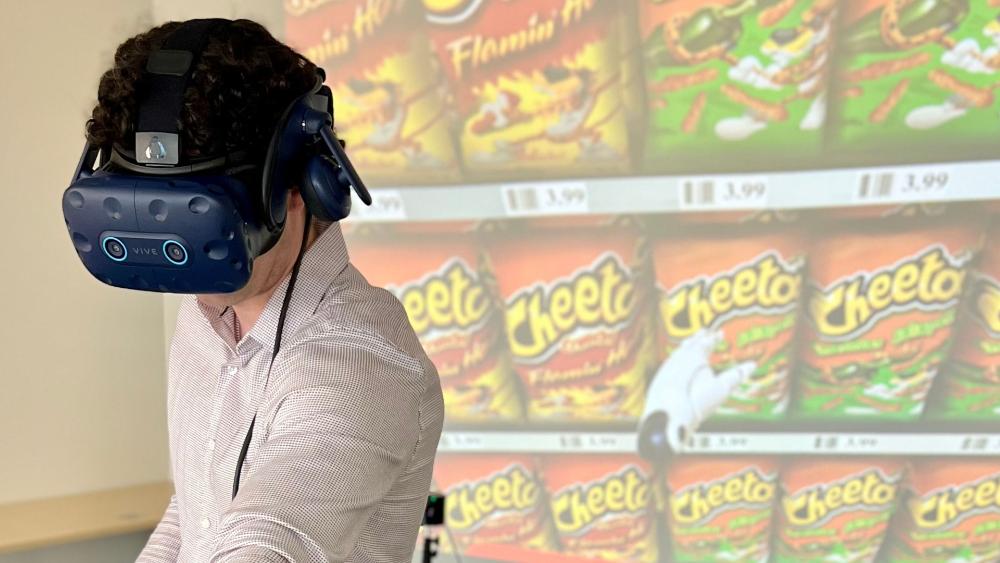VR Store
Virtual Reality Store Opens the Doors to Easier Consumer Behavior Research

Retail leaders know how important it is to make data-driven decisions. They want the confidence of making changes based on scientific evidence, not hunches.
But consumer behavior research is labor-intensive and can disrupt store operations, so sometimes retailers resort to using “instinct” and “experience” to guide decisions rather than facts.
Through collaboration with two Saint Mary’s University alumni, the David Sobey Centre is pioneering a way to make consumer behavior research more practical for retailers. The Centre now includes a Virtual Reality (VR) Store, allowing researchers to easily manipulate the store environment to measure how “shoppers” respond to changes in things such as merchandising, store layout, pricing, advertising, and more.
Why traditional consumer research is such a hassle
Scientific protocols are rigorous procedures designed for the lab, not a functioning store. Consumer behavior research carried out in a physical store, requires the retailer to cordon off part of the floor for an extended period of time, often spanning several hours to a couple of days as a series of trials are conducted. Throughout these trials, diverse interventions are implemented, ranging from altering product prices to reconfiguring merchandising displays and even entire shelving units, while numerous participants navigate through the studies, further obstructing aisles. The magnitude of this undertaking is not only resource-intensive but also inherently disruptive to regular store operations, inevitably leading to a substantial impact on sales. At the end of the day, many retailers consider the hassle worth more than the data that could result from it.
Making rigorous research more doable
Virtual reality offers an innovative solution by providing a controlled environment that eliminates in-store disruptions, enabling seamless and comprehensive consumer behavior research without impeding the natural flow of a physical store. The VR technology also allows researchers to collect and analyze a diverse range of data, encompassing insights into items picked up, returned, or added to the shopping cart. The incorporation of built-in eye tracking technology further enhances the research capabilities, capturing valuable information on customer gaze patterns, the duration of their focus, and generating insightful heat maps of the shelf to visualize eye movements. This multifaceted data collection within the virtual realm offers a nuanced understanding of consumer interactions, elevating the precision and depth of consumer behavior research.
SMU collaboration at work
The DSC is leading the way in using VR for customer behavior research thanks to the SMU spirit of student entrepreneurship. The VR Store has emerged as a creative collaboration between the Centre and two alumni, Mike Cyr and Diogo Farinho, who started a VR-based company while they were still students.
Cyr and Farinho founded Nanuk Technologies in 2017, focusing on the real estate sector. Nanuk creates VR solutions to help realtors sell buildings in the pre-construction phase, and the David Sobey Centre saw how their software could lead to innovation in retail research too.
Such creative partnerships are key to the David Sobey Centre’s ability to generate innovative solutions to retail problems. Going forward, the VR store will open possibilities for collaboration with retailers who want to access rich, reliable consumer data without having to turn their store into a temporary research lab
What’s next
So far, the VR Store has just scratched the surface of the research potential it has unlocked. The DSC and Nanuk are continuing to refine the software, making it easier for researchers to add inventory, adjust prices, and change product placement. They’re also exploring ways to integrate biometric capabilities besides eye-tracking. For instance, down the road, it may be possible for researchers to supplement the VR goggles with an EEG headset so they can observe how patterns of brain activity align with shopping behavior.
Looking for data insights into your customers? Connect with us to explore collaborative possibilities.